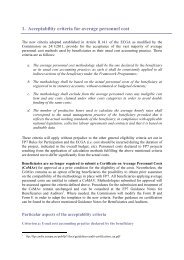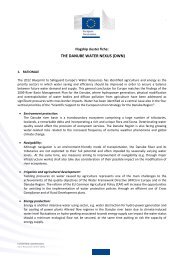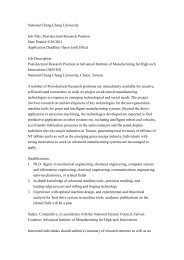Guide to Research and Innovation Strategies for Smart Specialisation
Guide to Research and Innovation Strategies for Smart Specialisation
Guide to Research and Innovation Strategies for Smart Specialisation
You also want an ePaper? Increase the reach of your titles
YUMPU automatically turns print PDFs into web optimized ePapers that Google loves.
Step 4 - Identification of Priorities<br />
<strong>Smart</strong> specialisation involves making smart choices. In fact, smart specialisation is all about<br />
facilitating that choice, selecting the right priorities <strong>and</strong> channelling resources <strong>to</strong>wards those<br />
investments that have the potentially highest impact on the regional economy. The priority<br />
setting <strong>for</strong> national <strong>and</strong>/or regional research <strong>and</strong> innovation strategies <strong>for</strong> smart specialisation<br />
should consist of the identification of a limited number of innovation <strong>and</strong> knowledge-based<br />
development priorities in line with existing or potential sec<strong>to</strong>rs <strong>for</strong> smart specialisation, on the<br />
basis of the elements <strong>and</strong> steps presented in this guide.<br />
Priorities in RIS3 need <strong>to</strong>:<br />
• Define concrete <strong>and</strong> achievable objectives. These objectives should be based on present<br />
<strong>and</strong> future competitive advantage <strong>and</strong> potential <strong>for</strong> excellence, as derived from the analysis<br />
of regional potential <strong>for</strong> innovation-driven differentiation.<br />
• In addition <strong>to</strong> technological, sec<strong>to</strong>ral or cross-sec<strong>to</strong>ral priority areas, horizontal priorities<br />
need <strong>to</strong> be defined. These could involve the diffusion <strong>and</strong>/or application of Key Enabling<br />
Technologies (see Annex II), aspects related <strong>to</strong> social innovation, or the financing of<br />
growth of newly established companies, which is often a bottleneck in many regions that<br />
have prioritized the creation of new technology-based firms but fail <strong>to</strong> see these firms grow<br />
<strong>and</strong> create jobs.<br />
As has been explained in previous sections, the selection process needs <strong>to</strong> be based on<br />
quantitative as well as qualitative in<strong>for</strong>mation on the different possible domains <strong>for</strong> a<br />
national/regional smart specialisation. The key criteria <strong>for</strong> filtering the range of possible priority<br />
areas down <strong>to</strong> only a few priorities are:<br />
• the existence of key assets <strong>and</strong> capabilities (incl. specialized skills <strong>and</strong> pool of labour) <strong>for</strong><br />
each of the areas proposed <strong>and</strong>, if possible, an original combination of these (cross-sec<strong>to</strong>r;<br />
cross-cluster),<br />
• the diversification potential of these sec<strong>to</strong>rs, cross-sec<strong>to</strong>rs or domains,<br />
• critical mass <strong>and</strong>/or critical potential within each sec<strong>to</strong>r,<br />
• the international position of the region as a local node in global value chains.<br />
All this relevant in<strong>for</strong>mation is <strong>to</strong> be examined by decision/policy-makers in order <strong>to</strong> select a few<br />
priorities focusing on the existing strengths of the economy but also on emerging opportunities.<br />
A good smart specialisation strategy will catalyze structural change <strong>and</strong> the emergence of critical<br />
clusters so that agglomeration externalities, economies of scale, economies of scope <strong>and</strong> local<br />
spillovers can be fully realized in the process of knowledge production <strong>and</strong> distribution.<br />
A regional economy provides clearly the appropriate dimensional framework <strong>for</strong> such processes<br />
of decision, strategic implementation, agglomeration of resources <strong>and</strong> materialisation of<br />
spillovers. However, national economies might also be a good framework, particularly in the<br />
case of small countries.<br />
52

















